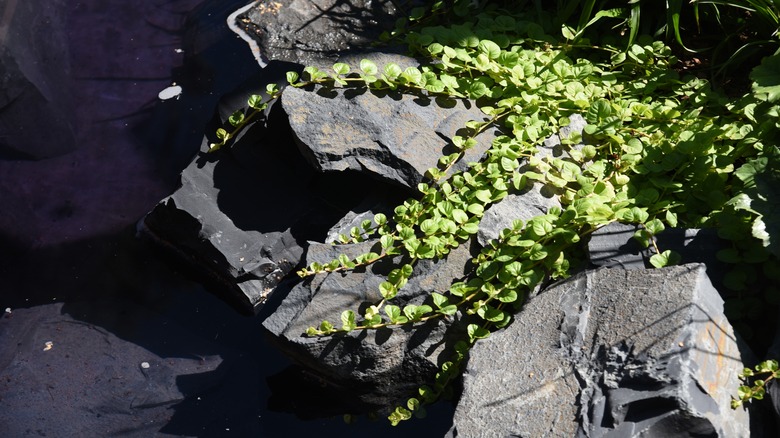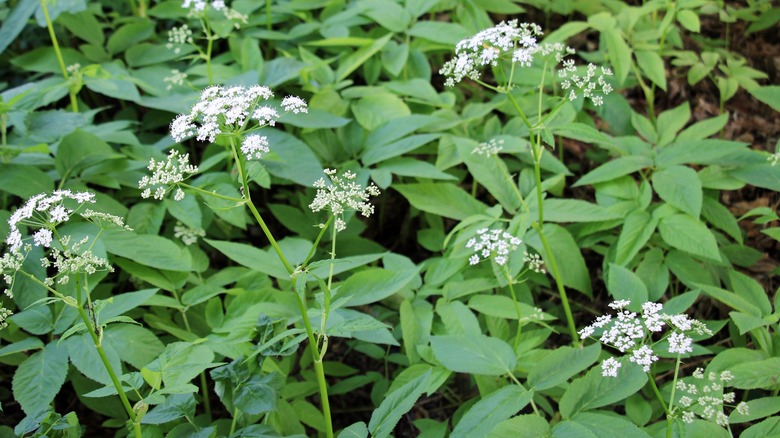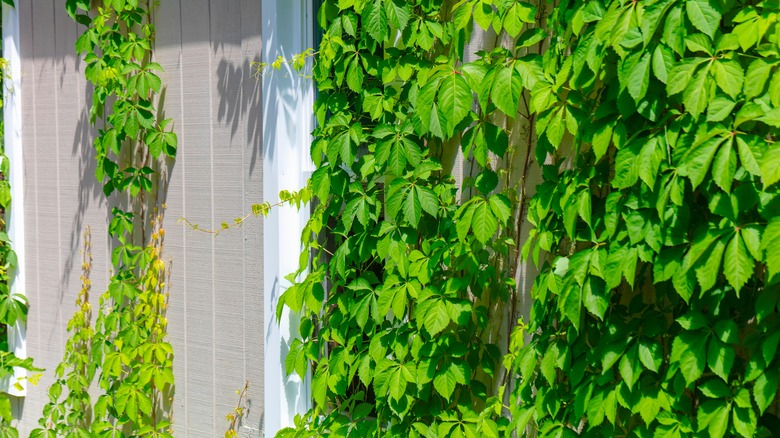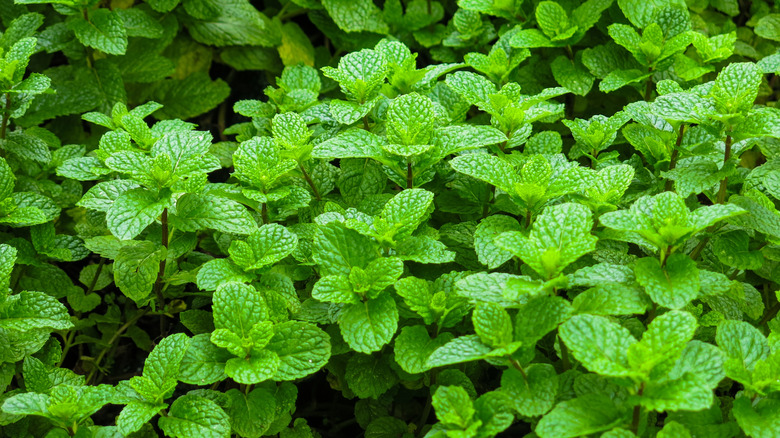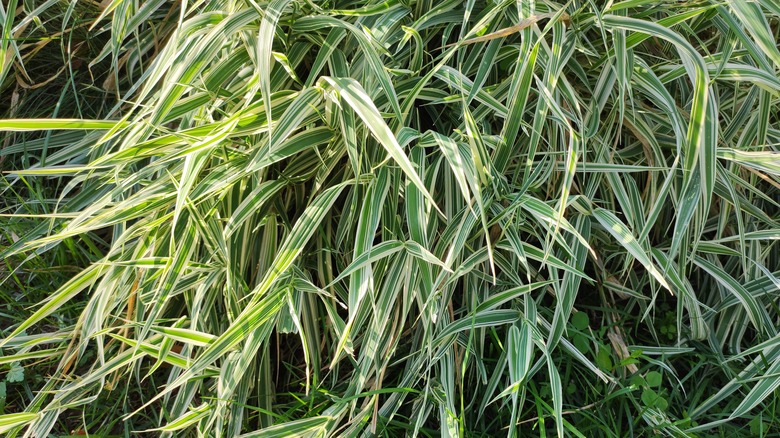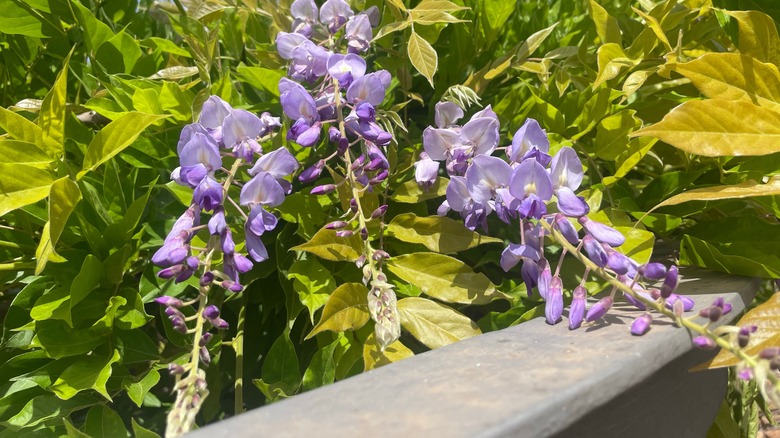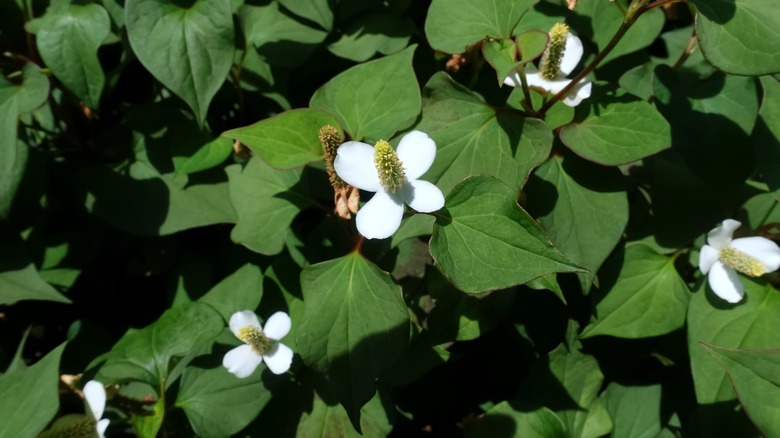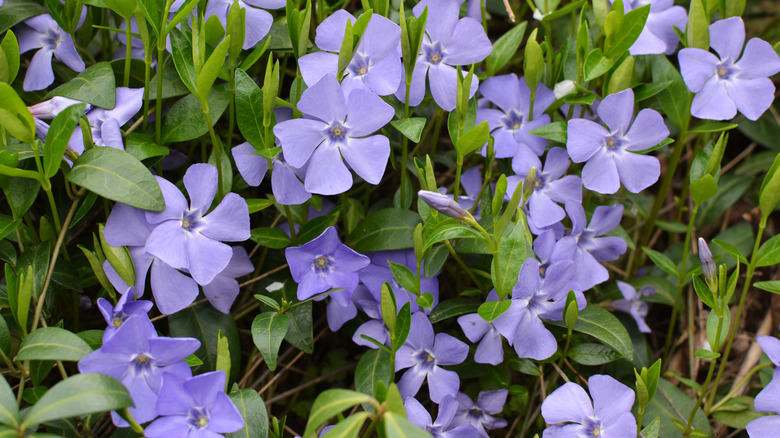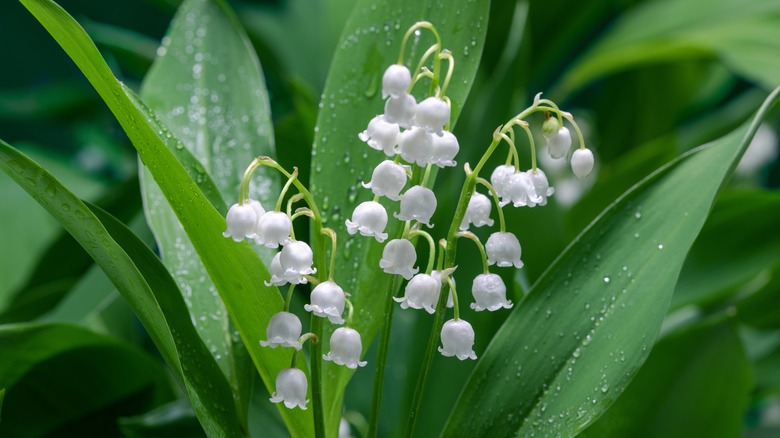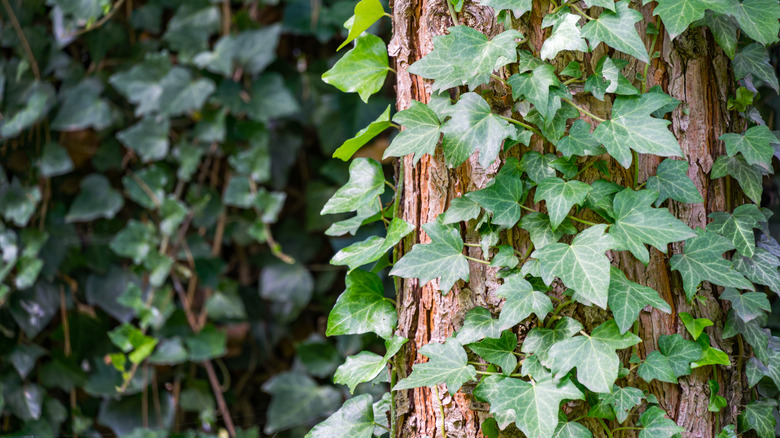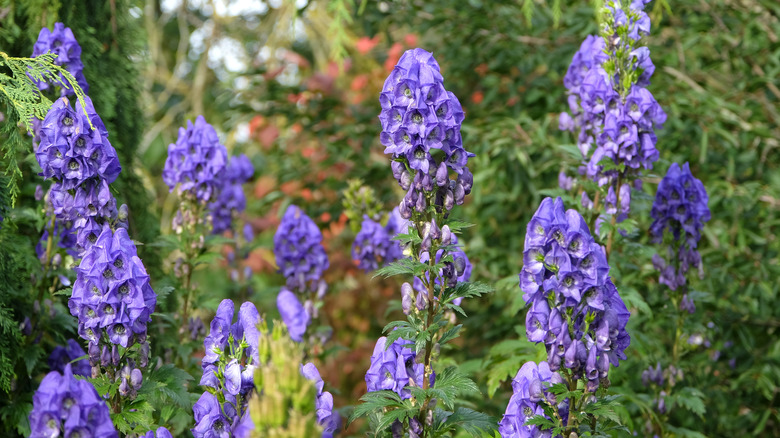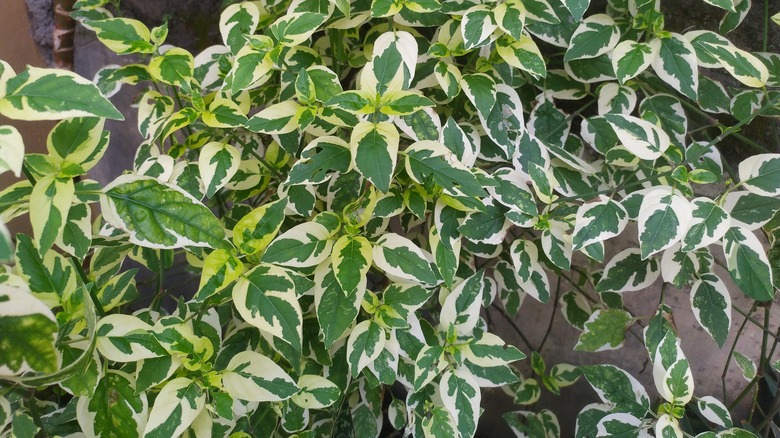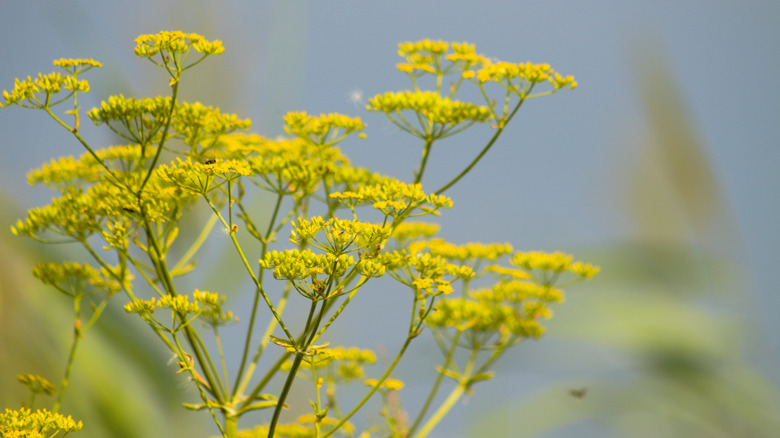15 Ground Covers That Aren't Worth Planting In Your Yard Or Garden And Why
Ground covers can be fantastic for any garden. There are lots of wonderful reasons to plant these fast-spreading plants, including that they crowd out weeds and can be a beautiful, low-maintenance addition to any garden where grasses won't grow. They also hold soil in place, preventing common types of soil erosion.
They're incredibly versatile, too, since you can find the best ground cover for all soil types. Typically, ground covers grow fairly close to the ground (thus their name), and they "cover" larger areas since they do spread. But there are differences between well-behaving and misbehaving ground covers. While you may want ground cover in certain areas, no one wants a plant that completely takes over and crowds out flowers or other blooming shrubs. Invasive ground covers, such as creeping Jenny or English ivy, can quickly grow out of control. Plants like carpet box or wisteria might hurt trees. And some vining plants, like Virginia creeper, can even damage fences or walls.
Sprawling, overly aggressive plants aren't the only thing to worry about, either. Other ground covers, such as aconite, can be toxic or poisonous to pets or people. So you've got a few reasons to be careful about what you plant and where. If you don't want to grapple with any of these problems, then here are 15 kinds of ground covers you should simply avoid.
Creeping Jenny might creep too much
Creeping Jenny (Lysimachia nummularia) is just like its name suggests — a vine-like ground cover that likes to creep. You might know creeping Jenny from its other names, like moneywort or herb twopence, and it prefers humid and wet environments but can adapt to drier soil. It can be invasive because it grows in a thick cover in all directions, and sets down roots easily. It also boasts a pretty yellow flower every summer. Still, it's best kept contained in a pot if you don't want it to creep through your whole garden.
Bishop's weed won't play nice
Bishop's weed (Aegopodium podagaria) might have you feeling checkmated in a garden game of chess, because it simply doesn't play fair. The invasive plant, also known as goutweed since it was once used to treat gout, is found on the eastern seaboard, the Midwest, and even the Pacific Northwest. It's unwelcome in most places, and even made Vermont's noxious weed watchlist. You'll not find it in stores in Connecticut and Massachusetts since it's banned there. Once planted, it spreads seeds through the white flowers that appear in the spring or early summer.
Virginia creeper can damage your fence or house
The no-fuss Virginia creeper (Parthenocissus quinquefolia) seems like the perfect ground cover. It even changes color in the fall, producing a pop of red or purple. But don't let its pretty leaves fool you — it will take over your yard. One vine can grow 50 feet or more, and it can snake up any fence, tree or shrub, anchoring itself with sucker disks on its vines. Virginia creeper can damage anything that's painted, including fences or your house. Even worse, the plant is extremely flammable, so shouldn't be near your house anyway.
Mint won't leave you feeling fresh
While mint can be great in tea and desserts, it can quickly grow out of control in your garden. Mint and its most common varieties, peppermint (Mentha x piperita) and spearmint (Mentha spicata), are hearty and easy to grow, but they're best planted in confined containers where they can't spread. Mint might seem like a great ground cover that can double as a nice herb, but once you plant mint in your garden, you'll have nothing but mint — all the time, everywhere.
Ribbon grass will overreach
Ribbon grass (Phalaris arundinacea) grows easily ... perhaps too easily, which is why it can get out of control in your garden. It'll quickly take over your entire flower bed. It's even banned in a few states on the West Coast and is officially considered to be an invasive plant in the Midwest, because it can get so out of hand so very fast. It might be great in containers or fenced in. But if left unchecked, it will take over, much like certain types of bamboo, and grow undeterred everywhere.
Some wisteria vines will also choke trees
Some species of wisteria such as Chinese wisteria, (Wisteria sinensis) and Japanese wisteria (Wisteria floribunda) might be beautiful blooming vines, but they're also incredibly invasive. They're so out of control, that they're banned and restricted in many states, including Maryland and Wisconsin. If they take hold in your favorite tree or shrub, they wrap so tightly around it that they eventually kill it. While the purple flowers are beautiful, this woody vine can be hard to control, and it's best kept out of your flowerbeds. Consider American wisteria instead.
Chameleon plant won't disguise its overgrowth
Chameleon plant (Houttuynia cordata) seems like a pretty addition at first, especially when it blooms small white flowers late in the season during autumn. But even with its pretty blooms, you might want to skip this aggressive grower, which can take over flower beds and gardens in the blink of an eye. If you do plant it, it needs hard borders like a stone pathway or a raised flower bed barrier to keep it in line. Something like golden groundsel might work as an alternative.
Periwinkle will take over in a blink
Periwinkle or running myrtle (Vinca minor) lures you in with pretty purple blooms, but it will also take over your flower beds in the blink of an eye. Periwinkle can jump from beds to lawns quickly and will take over nearly any space it can find because it grows long stems that immediately dig roots into the ground. It will blend into other plants so quickly, you'll likely spend a lot of time trying to fight it back. It's officially labeled as an invasive plant in many states, including North Carolina.
Lily of the valley can make you sick
Lily of the valley (Convallaria majalis) can be both invasive and toxic. The roots are the most poisonous, but the whole plant is toxic both for pets and people. Known for its white flowers, the plant also produces sweet red berries, which could be a danger to small children. Lily of the valley contains toxins that attack the heart and also cause blood clotting. It's poisonous to eat, but some people can also get rashes from touching it, so it's best to keep this plant out of your garden.
When English ivy moves in, no tree is safe
English ivy (Hedera helix) should be on every gardener's no-grow list. It will grow literally in all directions, and it loves nothing more than to stretch up vertically into the nearest tree. It will keep growing into its branches, until it chokes off its leaves from sunlight, or makes it so heavy that it's likely to topple. Ivy is almost impossible to get rid of once it's gotten a foothold, but a natural remedy to eliminate English ivy includes using a mixture of vinegar, salt, and dish soap.
Carpet box might compete too much with your trees
Carpet box (Pachysandra terminalis) will grow in shady spots beneath trees, and it's evergreen, which makes it seem like the best ground cover to put there, but beware. While it won't grow up into your trees, carpet box can spread uncontrolled, and it might even steal valuable nutrients from tree roots. It's probably not going to kill your tree, but it certainly could prevent it from reaching its full potential. It's best to avoid planting anything beneath your tree, and just opt for mulch for a clean look instead.
Some ground covers, like aconite, can be toxic
Aconite, also known as blue rocket, the devil's helmet, or wolfsbane, is a perennial in the buttercup family, and it's highly poisonous. Raw aconite is toxic, especially its roots, and it's bad both to eat it and even to touch it. The toxins in the plant can attack both your nervous system and your heart and can be harmful even in very low doses. Even worse, there's no known antidote. It's best not to have this in your garden where you could put children or pets at risk.
Winter creeper won't just take over, it'll make you ill
Birds love the berries of winter creeper or climbing euonymus (Euonymus fortunei), which is often how they get replanted and spread, but people should avoid them at all costs as they can be poisonous. Plus, the plant will spread quickly, and can take over trees and push out flowers and other desired blooms. It's considered invasive in North Carolina and several states along the East Coast, so avoid planting this one unless you want to spend a lot of time in the garden rooting it out.
Wild parsnip can cause blisters
Wild parsnip (Pastinaca sativa) isn't deadly, but it's still toxic. The sap from it can cause painful blisters or skin irritations, so if you're in a battle with trying to remove it from your garden beds, you might lose. Like other out of control ground coves, wild parsnip will take over your garden if left to its own devices, and it'll crowd out your flowers and other plants. Wild parsnip is restricted or prohibited in several states, including Wisconsin and Minnesota. A popular alternative is golden Alexander.
Cushion spurge is also toxic
Cushion spurge (Euphorbia epithymoides) grows up in spongey bunches and can cover a lot of space. It's a pretty plant that blooms in the spring and changes color in the fall, but keep in mind that it's also toxic, too. It's poisonous if you eat it and also if you touch any of the sap. If you're cutting it in the garden, then definitely wear gloves, because if you get any of its milky-white sap on your skin, you could get a rash. It'll also irritate your eyes as well.

